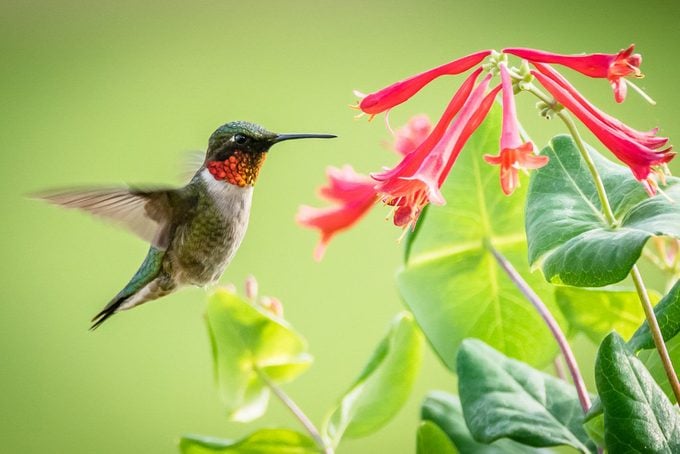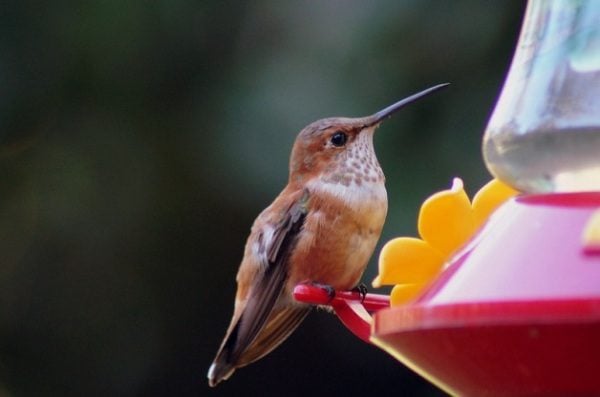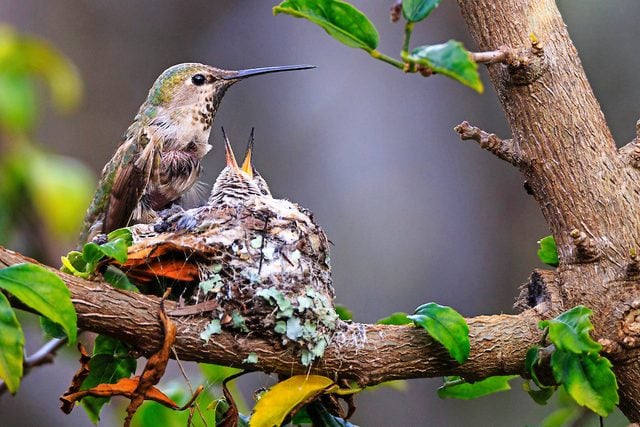How to Attract Hummingbirds: 10 Expert Tips
Updated: May 24, 2023
Attracting hummingbirds is easy when you start thinking like a hummingbird! Birding experts explain how to attract hummingbirds and keep them coming back.
Our editors and experts handpick every product we feature. We may earn a commission from your purchases.
Hummingbirds are some of the most fascinating and flashy fliers you’ll ever see. Yet they’re also some of the most misunderstood. If you want to know how attract hummingbirds and keep them coming around (and don’t we all?) you might not be sure how to get started. After all, a lot of information is out there, and it’s a little overwhelming trying to decide what to believe or try. To provide a little insight into these tiny feathered gems, we thought we would get inside their heads a bit and think the way they do. Of course, we can’t really think like hummingbirds. But we have studied their behavior enough over the years to make some good guesses about what they’re thinking. Fortunately, it’s easy to draw these flying gems to your garden with fuel-providing feeders and native plants. Here’s the best ways to attract hummingbirds.
How to Attract Hummingbirds: Plant Red Flowers

In North America, the flowers best adapted for hummingbird pollination are bright red blooms with a tubular shape. Hummingbirds instinctively watch for red things and investigate them. (We’ve seen them making detours to check out the taillights of parked cars, and even someone’s sunburned nose!) There’s no question that planting red flowers will attract hummingbirds. Provide plenty of native nectar plants that will supply shelter and help attract the small insects hummingbirds rely on for protein. Tube-shaped red and orange flowers, like honeysuckle or trumpet creeper, are common hummer favorites. Visit your local native plant nursery and ask for suggestions for your area.
Offer Sugar Water
Anusha Shankar, a postdoctoral fellow conducting research at the Cornell Lab of Ornithology, explains why these magnificent birds are always on the hunt. She says, “Hummingbirds need to eat constantly because they use up energy very quickly. If we had their metabolic rate, we’d need to eat 300 hamburgers a day to survive!” Nectar feeders are a popular choice for attracting these fliers. Some companies sell hummingbird nectar, but you can easily make your own. Measure out 1 part white sugar to 4 parts water and mix thoroughly. If you boil the mixture to remove impurities, it may keep longer before it starts to spoil. And don’t mix in any honey, red dye or other additives when feeding hummingbirds. Simple sugar and water work just fine to attract hummingbirds.

Keep Feeders Clean to Attract Hummingbirds
Once you know how to attract hummingbirds, you need to be a responsible hummingbird admirer. Sugar water that has started to grow moldy can be dangerous to birds. If you’re going to put out feeders, it’s essential that you keep them clean and replace the mixture regularly—at least once every three or four days, more often in hot weather. If the mixture starts to look cloudy, clean the feeder and replace the nectar immediately. Saucer-shaped feeders with multiple ports are easy to clean, making them a favorite style.
“Hummingbirds can get sick at dirty feeders,” Anusha says. “If you see black gunk growing in your feeders and you can’t keep them clean enough, it’s better to take them down.” Sanitize them with hot water and a weak vinegar or bleach solution, rinsing well. Skip the dish soap, as it can leave a residue.
Psst—we found natural ways to keep bees and wasps away from hummingbird feeders.
Make Feeders Easy for Hummingbirds to Find
Put feeders out a few weeks before hummingbirds are expected in spring, and leave them up until the birds head south again in the fall. In areas where hummers are year-round residents, you can feed them throughout the seasons. Hummingbirds are always looking around for food sources, and they’re good at finding them, but you’ll have more luck attracting hummingbirds if you put feeders in a place where it’s easy to spot. Use a hummingbird feeder with some bright red on it, and position it where it can be seen by birds flying past at a distance. Don’t be tempted to add red coloring to your nectar, though. Anusha notes that it’s potentially toxic to hummingbirds and unnecessary. Done all this but still not attracting any hummingbirds? You might be making one of these hummingbird feeder mistakes.
Give Hummingbirds Some Space
Goldfinches and some other songbirds may feed together peacefully, but hummingbirds often fight around feeders, chasing one another away. Hummingbirds are adapted to feeding at flowers, which will produce only limited amounts of nectar, so they instinctively protect their food sources even when they’re at feeders with an unlimited supply. Try putting up two or more feeders that can’t be seen from one another. Even the toughest little hummingbird can’t monopolize multiple feeders if he or she can’t see them all at once. Males are extremely territorial, so space them at least 15 feet apart, if possible.
Learn how to choose the best hummingbird feeder.
To Attract Hummingbirds, Place Feeders in the Same Place as Last Year
If the hummingbirds returning in spring seem to remember where you had flowers or feeders in previous years, they probably do. As tiny creatures that rely on specialized food sources in a big, big world, they have to be good at finding their way back to the best spots. They have a highly developed sense of what scientists call spatial memory. This is a good reason to work extra hard at attracting hummingbirds. Once you get them established, they’ll be back for more.
Learn how to create an ideal hummingbird habitat.
Hummingbirds Like Birdbaths
Like all animals, hummers need fresh water for drinking and bathing. They especially love to play in water mists and sprays, so add a small solar-powered fountain to your birdbath to see them in action.
Feeding Hummingbirds Doesn’t Delay Migration
While the hummingbirds enjoy having your backyard as a nectar source, they aren’t relying on you 100 percent. One of the top questions we are asked is: “If I have my feeder out in fall, will it keep the hummingbirds from migrating?” The answer is no – feeding hummingbirds will not stop them from migrating. They’ll migrate when they’re ready, whether or not feeders are available. It’s instinct!
Check out more questions about hummingbird feeders answered by experts.

Hummingbird Pairs Don’t Stay Together
Backyard birders sometimes worry because they had a pair of hummingbirds around and then the male disappeared, leaving a single mother behind. But this is normal for hummingbirds. The male never helps with nest building, incubation or feeding the young. The amazing female hummingbird does all that work herself. Meanwhile, the male goes off in search of another female. It seems odd to humans, but this behavior ensures that there will be even more hummingbirds for us to enjoy!
Here’s everything you need to know about hummingbird nests.
Be Patient for Hummingbirds to Visit
It may take some time to attract hummingbirds to your feeder—and even after they do, it may be a while before you notice that they’re visiting. They may zip in to the feeder for a quick sip many times before you happen to catch them in the act. So keep feeding hummingbirds, and keep watching. You’re likely to be rewarded.
Next, check out the best gifts for hummingbird lovers.
